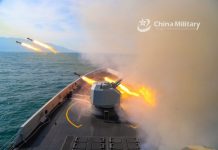India and Myanmar have shared a very interesting relationship in the past. The reluctance to engage with the Indian insurgents in the forests of Myanmar had set doubts in India about the relationship with the nation. The lack of military prowess and an incapacity to reach the inhospitable reaches of the forested regions made for a meek alliance. But the things have changed between India and Myanmar.
Silent on China, Vociferous on Myanmar: Double Standards of Islamic Nations on Rohingyas and Uighurs
In the last few years, with the advent of the Act East Policy, there is a stark change in the relationship we share with our neighbours. There have been increased initiatives to promulgate Indian influence in the region. With the Chinese forces vying for influence and possible inward movement to the Indian borders, the Act East policy can be seen as an important cornerstone in Indian diplomacy. The East has been overlooked for far too long within Indian foreign policy circles, this added impetus only adds to the armour.
India has engaged with the Myanmarese military in helping them with training in the Officer’s Training Academy near Bodh Gaya. Recently, a five-member Myanmarese delegation led by Commander-in-Chief (Air) General Muang Maung Kyaw visited Bodh Gaya accompanied by Indian Army Chief Bipin Rawat and Indian Air Force Chief BS Dhanoa. This has been one of many parleys between the two nations in the past couple of years.
India has helped Myanmar consolidate militarily in terms of weapons and logistics which include hundreds of 105 mm guns from old Indian Army tanks, Carl Gustaf rocket launchers among other weapons. The two nations have also indulged in sharing information and maintaining a steady supply of intelligence. The frequent meetings during the first term of Modi’s reign have found potency in that Delhi is looking to consolidate its position of relevance within the dynamics of South East Asia.
Vietnam a Major Player in India’s Act East Policy to Counter Chinese Aggression
India and Myanmar have primarily focussed on security and defence relations. The two countries have also run many military operations to flush out militants. The India-Myanmar Bilateral Military Exercise (IMBAX-2017) is focussed on peacekeeping missions. Both nations also participated in the India-Myanmar Bilateral Naval Exercise (IMNEX-18) in which the naval forces of the two countries participated in a combined exercise.
For India, the North-East insurgencies have cost a lot many lives and according to intelligence reports, most insurgents have found to be using the Myanmar borders to hide until they strike again.
The involvement with the Myanmar government provides India with increased initiative and impetus to annihilate the constant threat of violence within Indian birders. In 2017, the agreement on maritime security cooperation was signed between the two nations to coordinate and share information on activities in the maritime coasts of these countries. India has also been part of Myanmar’s very public internal problems. India was a part of Myanmar’s Nationwide Ceasefire Agreement in February 2018 and October 2015.
In the article by Sanjib Baruah, he points out the reason behind the shift in policy in recent years towards the East.
India’s ‘Act East Policy’ and China’s ‘One Belt One Road’ Compliment Each Other
“Myanmar is also a space in which India and China are trying to spread their influence. Besides strategic plans for expanding and spreading influence, economics is also the name of the game. China sees in Myanmar a route to the Indian Ocean to bring in its oil supplies through pipelines. For India, pursuing its Act East policy in all sincerity, access through Myanmar to link up with the vibrant dynamics of South East Asia is a must.”
India also has vested economic interests in South East Asia, the Association of South East Asian Nations (ASEAN) is one of the most economically dynamic blocs. The construction of the Asian Trilateral Highway which is said to connect India to the ASEAN nations is being brought together with Myanmar and Thailand. The Indian initiated road-river-port cargo transport project, Kaladan, would propel not just Myanmar’s economy but also provide for an alternative trade route for good in North-East India.
In 2018, India and Myanmar signed the Land Border Crossing Agreement which has been a relief to the North-East region of India. The simultaneous opening of international checkpoints at Tamu-Moreh and Rihkhawdar-Zowkhawtar borders officially cemented the agreement.
Indian Military Base In Sabang, Indonesia Can Strangle China At The Strait of Malacca
The Bay of Bay of Bengal Initiative for Multi-Sectoral Technical and Economic Cooperation (BIMSTEC) has Myanmar to be a key component to help unite the South and South East Asian nations. The fulfilment of this coalition would help India in winning points for coordinating an association which has long blamed Pakistan for inhibiting the South Asia Association for Regional Cooperation (SAARC) vision. The many initiatives taken by the incumbent government can be seen as a medium to increase pressure on Pakistan.
Myanmar is the only ASEAN nation with which India shares a land border. Not just that, India and Myanmar share similar cultural and religious inclinations. The Bodh Gaya visit may have well been one of the many ways India has catered to the fancies of their neighbours.
Indian Naval Base in Andaman Island a Key “Cog in the Wheel” to Control Strait of Malacca
In 2018, 60 couples from the Myanmar Army were invited to visit the Bodh Gaya. India will also be assisting with the final restoration of the historic Ananda Temple in Bagan. The Cabinet approved the restoration of the pagodas that were destroyed in the 2016 earthquakes that ravaged the region.
The two nations have a historical and cultural connection that is far from forgettable. The strengthening of ties could bring Myanmar back to its foot after almost 50 years of military rule and could give India a place of power and influence in the region. Something that has long eluded Delhi.




